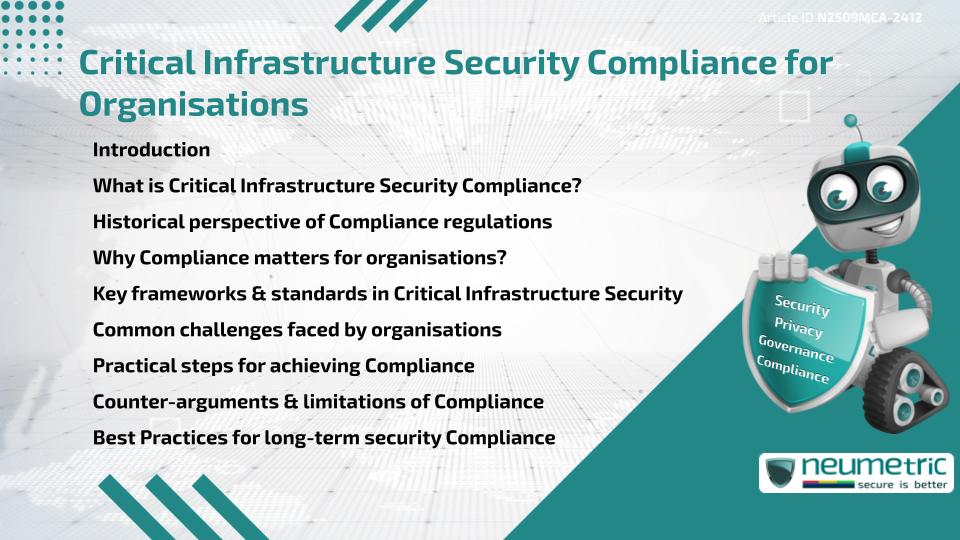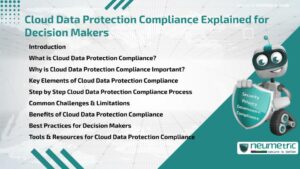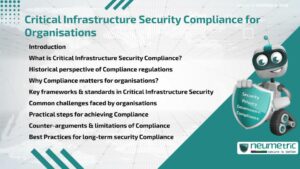Table of Contents
ToggleIntroduction
Critical Infrastructure Security Compliance is the process by which organisations protect essential systems such as Energy, Transport, Water supply, Healthcare & Communication from Cyber Threats & Physical Risks. It ensures resilience, prevents disruption & aligns with Legal & Industry Regulations. Organisations that fail to meet Compliance standards not only face penalties but also Risk damaging public safety & national security. This article explains what Critical Infrastructure Security Compliance involves, its historical context, the main frameworks, challenges & actionable strategies for organisations to achieve Compliance effectively.
What is Critical Infrastructure Security Compliance?
Critical Infrastructure Security Compliance refers to the set of Rules, Standards & Best Practices that organisations must follow to protect assets deemed vital to society. These assets are so essential that their loss or compromise could cause severe economic, social or public health consequences. Compliance ensures that organisations adopt Preventive Measures, monitor Threats & respond swiftly to Incidents.
Think of Compliance as the safety belt for an organisation’s most crucial functions. Just as wearing a belt does not stop accidents from happening but greatly reduces harm, Compliance does not eliminate all Threats but minimises the Risk of catastrophic impact.
Historical perspective of Compliance regulations
The concept of protecting critical infrastructure gained prominence after widespread power outages in the late twentieth century & the increased reliance on digital systems. Governments worldwide recognised the Vulnerability of essential services to both natural disasters & cyberattacks. Regulations such as the United States’ NIST Cybersecurity Framework, the European Union’s NIS Directive & Australia’s Security of Critical Infrastructure Act highlight the global recognition of these Risks.
Historically, Compliance was reactive, focusing on responding to Incidents. Over time, it shifted toward proactive models that emphasise prevention, Continuous Monitoring & Resilience planning.
Why Compliance matters for organisations?
For organisations managing critical infrastructure, Compliance is not optional. It brings several benefits:
- Legal protection: Many countries mandate Compliance under National Security Laws.
- Risk reduction: It reduces Vulnerabilities to cyberattacks, sabotage or natural hazards.
- Reputation management: Customers & Partners trust compliant organisations more.
- Operational resilience: Compliance requires Business Continuity planning, ensuring operations can continue during crises.
Without Compliance, an organisation may face fines, lawsuits & reputational loss that could take years to recover from.
Key frameworks & standards in Critical Infrastructure Security
Several international & national frameworks guide organisations:
- ISO/IEC 27001: A globally recognised Information Security management standard.
- NIST Cybersecurity Framework: Widely adopted for managing & reducing cyber Risks.
- CIS Critical Security Controls: Practical steps to improve security posture.
- National laws like the EU’s NIS Directive & Australia’s Security of Critical Infrastructure Act.
Each Framework provides structured guidelines to identify Risks, implement Controls & monitor Compliance. Organisations often use a combination to meet regional & industry-specific requirements.
Common challenges faced by organisations
Achieving Critical Infrastructure Security Compliance is complex. Some common challenges include:
- High costs: Implementing Compliance measures requires significant Financial investment.
- Rapidly evolving Threats: Cyber Risks change faster than regulations can adapt.
- Complex supply chains: Vendors & Third Party Partners may introduce Vulnerabilities.
- Resource limitations: Smaller organisations may lack the expertise to meet Compliance standards.
Compliance can feel like an endless race where the track keeps changing, but organisations cannot afford to stop running.
Practical steps for achieving Compliance
Organisations can take several steps to simplify Compliance:
- Conduct Risk Assessments to identify Vulnerabilities.
- Map Compliance Requirements relevant to the industry & jurisdiction.
- Develop Security Policies that cover Access Control, Monitoring & Incident Response.
- Train Employees to recognise Cyber Threats & follow Security Protocols.
- Regularly Audit Systems to ensure standards are being maintained.
- Engage Third Party experts when internal resources are insufficient.
Taking a structured, phased approach helps organisations avoid being overwhelmed.
Counter-arguments & limitations of Compliance
While Compliance is essential, it is not foolproof. Critics argue that:
- Compliance can become a “checkbox exercise” where organisations meet minimum requirements without real security improvements.
- Regulations may lag behind fast-changing Threats, leaving Gaps.
- High Compliance costs may strain smaller organisations disproportionately.
These limitations remind us that Compliance should not be the end goal but rather a baseline. True security goes beyond Compliance, integrating resilience into the organisational culture.
Best Practices for long-term security Compliance
To sustain Compliance over time, organisations should:
- Establish a culture of Security Awareness across all departments.
- Integrate Compliance into strategic Decision-making.
- Continuously update Systems & Protocols to match evolving Threats.
- Build partnerships with Regulators & Industry Peers to share insights.
Long-term Compliance is less about ticking boxes & more about embedding security into everyday practices.
Conclusion
Critical Infrastructure Security Compliance is a vital safeguard for modern organisations. It protects public safety, ensures operational continuity & upholds legal responsibilities. While challenges & criticisms exist, Compliance remains a cornerstone of resilience in essential services.
Takeaways
- Critical Infrastructure Security Compliance protects essential services & national security.
- Regulations evolved from reactive to proactive models.
- Frameworks like ISO/IEC 27001 & NIST Cybersecurity Framework guide organisations.
- Common challenges include high Costs & fast-evolving Threats.
- Long-term Compliance requires cultural change, not just meeting Checklists.
FAQ
What does Critical Infrastructure Security Compliance cover?
It covers essential systems like Energy, Transport, Water, Healthcare & Communication.
Why is Compliance important for organisations?
It reduces Risks, ensures Legal protection, maintains Customer Trust & improves Operational Resilience.
Which frameworks are most relevant for Compliance?
ISO/IEC 27001, NIST Cybersecurity Framework, CIS Critical Security Controls & regional laws like the NIS Directive.
What are the biggest challenges to achieving Compliance?
High costs, evolving Threats, complex supply chains & limited resources.
How can smaller organisations manage Compliance effectively?
They can prioritise key Risks, use external experts & adopt phased approaches to avoid being overwhelmed.
Is Compliance the same as Security?
No, Compliance sets minimum standards while true Security requires ongoing vigilance & resilience planning.
Can Compliance prevent all attacks?
No, but it significantly reduces the Likelihood & Impact of Incidents.
Need help for Security, Privacy, Governance & VAPT?
Neumetric provides organisations the necessary help to achieve their Cybersecurity, Compliance, Governance, Privacy, Certifications & Pentesting needs.
Organisations & Businesses, specifically those which provide SaaS & AI Solutions in the Fintech, BFSI & other regulated sectors, usually need a Cybersecurity Partner for meeting & maintaining the ongoing Security & Privacy needs & requirements of their Enterprise Clients & Privacy conscious Customers.
SOC 2, ISO 27001, ISO 42001, NIST, HIPAA, HECVAT, EU GDPR are some of the Frameworks that are served by Fusion – a SaaS, multimodular, multitenant, centralised, automated, Cybersecurity & Compliance Management system.
Neumetric also provides Expert Services for technical security which covers VAPT for Web Applications, APIs, iOS & Android Mobile Apps, Security Testing for AWS & other Cloud Environments & Cloud Infrastructure & other similar scopes.
Reach out to us by Email or filling out the Contact Form…





